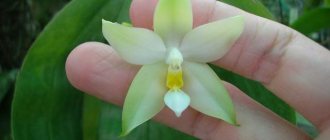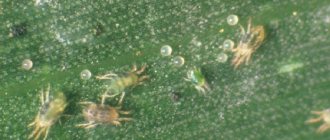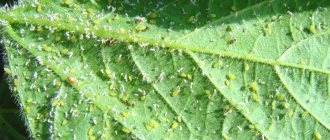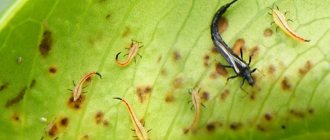Pathogens of fusarium
The cause of the disease on the orchid is moldy fungi from the genus Fusarium. Experts who studied the problem of the appearance, symptoms and spread of pathogens on orchid plants agreed that the root system, as a rule, is parasitized by the fungus Fusarium oxysporum, causing it to rot.
Another fungus was noticed on the aerial part - Fusarium moniliforme, and it mainly provokes first fusarium wilting of the leaves, stems, flowers and tuberidia of the orchid, and then rotting.
Causes of infection
If a favorable environment appears, the fungi awaken and begin active life.
The source of infection can be:
- prolonged low substrate temperature;
- soil is too wet;
- stagnant air, lack of circulation;
- spread from a diseased plant brought from outside.
Fungal spores very quickly colonize new territories if the environment is favorable for them and if the orchids are weakened.
If the disease has captured most of the plant, then its death is inevitable.
The conclusion is not complicated - the activation of the fungus is facilitated by prolonged discomfort for the plant: sudden changes in temperature, lack of lighting, combined with excess moisture in the substrate.
How to recognize fusarium on phalaenopsis and other orchids
Fusarium fungi spread through colorful conidia that are pink-crimson, purple, violet or white. If dust or small balls of the indicated color are noticed on the plant, then there is practically no doubt - the orchid is infected with Fusarium oxysporum. The fungus clogs the vessels of the tissues of the root or leaf blade, resulting in a dark depressed area.
It is initially difficult to diagnose fusarium on the root system of phalaenopsis, since the affected areas resemble a tan from bright sunlight. A lot of time passes - from 8 to 18 months - before depressed areas appear on the roots, as if pulled by a thread.
The “tanned” spots darken over time and become covered with multi-colored spores, and only at this stage does it become clear that the plant is infected with the fungus Fusarium oxysporum. At this time, the rot of the root system is already progressing with might and main, and the foliage, especially the old ones, instantly turns yellow and dies. The plant withers and has no chance of survival.
The onset of the disease does not necessarily occur from the root system. Often conidia appear in the core or on the stem. The affected areas turn yellow and red or simply look depressed and very soon acquire a brownish tint and rot. As a rule, this is how Fusarium moniliforme manifests itself, which is usually found on flowers, peduncles and foliage.
On Cattleyas, Dendrobiums, Laelias and Oncidiums, the symptoms of damage to the root system are similar to those of Phalaenopsis root disease, but at later stages, when the lesion creeps up the plant, purple or burgundy stains are clearly visible at the base of the tuberidia and on the rhizome. The infection of Paphiopedilum is also in many ways reminiscent of the appearance of a fungus on the roots of phalaenopsis, but it is concentrated at the neck of the root, developing wet rot at the base of the rosette, and the leaves are easily pulled out.
Anthracnose
Miltonia, oncidium, paphiopedilum, and phalaenopsis are most susceptible to the disease.
This disease most often appears on leaves and sometimes on pseudobulbs. Signs of anthracnose are small and round but distinct brown spots that may enlarge and coalesce over time. Large areas gradually become black and form dents. At a completely advanced stage, a yellowish or pinkish coating may appear on the spots. Most often, an orchid is affected by anthracnose due to too high air humidity, as well as stagnation of water in the axils of the leaves or in the core of the pseudobulbs. The causative agent of the disease is a fungus.
Areas affected by anthracnose should be cut off from the orchid and burned. The cut areas should be treated with activated carbon or ash. Copper-containing preparations, such as HOM or Horus, will help cure an orchid. They need to treat the flower three times with an interval of 10 days. After this, you should reduce watering and stop feeding the plant.
To prevent anthracnose from appearing on an orchid, it needs to be provided with air humidity of 40 to 70%. In addition, it is recommended to periodically ventilate the room with the flower so that the air does not stagnate, but circulates well. In addition, after watering, water from the leaf axils and cores of the pseudobulbs must be removed using a cloth or napkin.
Favorable conditions for the development of fusarium rot
An environment conducive to the emergence and development of fusarium rot pathogens is formed as a result of the presence of certain factors:
- an excess of salts in the substrate occurs not only as a result of violation of the doses of fertilizer or fertilizing regime, but also as a result of watering with tap water. Experienced orchid growers recommend replanting orchids at least every 2–3 years, but also rinsing the substrate with distilled water every 6–8 months;
- a high proportion of peat or polystyrene foam in the substrate, which lowers the overall pH and acidifies it to such an extent that beneficial microorganisms die, preventing the proliferation of fungi. The proportion of these components in the substrate should not exceed 10–20%;
- lack of drying of the soil mixture due to improperly organized irrigation regime;
- low temperature of the substrate inside the flower container, and this may not necessarily be obvious hypothermia, but also active evaporation after watering, as a result of which the roots become supercooled.
Prevention
To avoid Fusarium infection, follow these recommendations:
- ventilate the room and loosen the soil;
- do not allow the temperature to drop below -15 degrees;
- disinfect the soil before planting;
- observe the norm of peat and polystyrene in the soil - no more than 1/5 of the total mass;
- observe the watering regime - avoid frequent wetting;
- replant the orchid every 6 months;
- choose only special fertilizer complexes for orchids;
- place the flowerpot in a bright place, but avoid direct sunlight;
- Regularly inspect the crop for infestations and pests.
An orchid is a very capricious plant that requires constant care. Otherwise, the culture begins to hurt. But if you provide the flower with optimal development conditions, it will delight you with its lush blooms for a long time.
Treatment of fusarium rot on an orchid
An orchid grower who discovers symptoms similar to fusarium on his plants must immediately isolate the affected plants separately from healthy ones in another room, since the infection spreads very quickly to healthy orchids.
Next, you will have to decide what to do with the diseased orchid. It should be recalled that only a laboratory test will give one hundred percent confidence in the cause of the disease; it can easily be mistaken for fusarium and another problem, the same sunburn on the root system. That’s why you shouldn’t immediately cut off the reddened roots, but only take up the scissors when suspicious areas begin to change color or press in.
If, however, there is still no doubt about the culprit for the appearance of pink or white spore spots, you can try to save the flower even with a completely rotten root system, but with an intact above-ground part. To do this, all lifeless roots are removed, and the entire orchid is treated with a fungicide solution. It is selected based on the manufacturer’s instructions for use for certain diseases, including fusarium. Based on the opinions of experienced orchid growers who are dealing with saving their collection of home orchids from fusarium rot, in most cases foundationazole or benomyl helps.
It is necessary to remind flower growers that many methods of resuscitating indoor plants in the case of fusarium are not suitable, for example, greenhouses or soaking in water. After treatment, the plant is placed in a well-lit and moderately warm place, sprayed regularly, once a week.
The orchid must be in quarantine for at least 20 days. Only after this time, if there are no new signs of the spread of fungus on the plant, can you begin manipulations to restore the root system using any of the known methods of resuscitating orchids.
However, it is worth warning orchid growers that after quarantine they must be prepared for the fact that the plant will no longer help or need anything.
Preventive measures
Knowing that the development of the disease is facilitated by the weakened health of orchids and high humidity, a number of measures are observed, namely:
- Mandatory quarantine for a new copy.
- Regular ventilation of the room with orchids.
- Maintaining distance between pots. Control of humidity levels, both air and soil.
- Sterilize all working tools with alcohol.
- Treating the soil with copper sulfate. Calcination or freezing.
- Regular cleaning and disinfection.
- Timely removal of affected plants.
Signs of illness
The first symptoms of Fusarium infection are the appearance of pink-white small grains on the stem and in the root zone. With the passage of time and the development of the disease, the signs appear more clearly and on all parts of the plant:
- Roots. In the initial stages of the disease they become reddish, and later constrictions appear on them. In the final phase, the root system dies off.
- Leaves. The green foliage brightens, then turns yellow. The leaves curl and wither. The changes first affect the young upper leaves, moving from top to bottom.
- The stem begins to turn brown, becomes limp and thin.
- In places of cuts on the walls of blood vessels, dark brown rings can be observed.
Further care
It is recommended to process flowers on the day of watering, when high humidity remains. The orchid is treated especially carefully during plant growth, paying great attention to new shoots.
To stimulate the growth of new shoots on an orchid, a paste containing the hormone cytokinin is used . The flower pot should be placed in a warm, bright room. In this case, you need to avoid direct sunlight on the flowers. The leaves of the plant darken when there is a lack of light; if they turn yellow, this indicates an excess of light and heat.
Experienced gardeners recommend choosing light or transparent plastic pots for orchids to protect the roots from overheating. To ensure good ventilation of the roots, many holes are made at the bottom of the pot, and the bottom of the pot is covered with drainage.
Orchids are watered depending on the season - every 3 days in summer, every 10 days in winter. Orchids love moisture very much, so it is useful to periodically spray the plant with warm water. To avoid re-development of fungi, it is better to spray in the morning so that the moisture on the leaves has time to evaporate.
Proper feeding with special fertilizers is of great importance for weakened plants. In winter, fertilizing is carried out once every 30 days; during the germination of new shoots, fertilizer is applied every 2 weeks.











